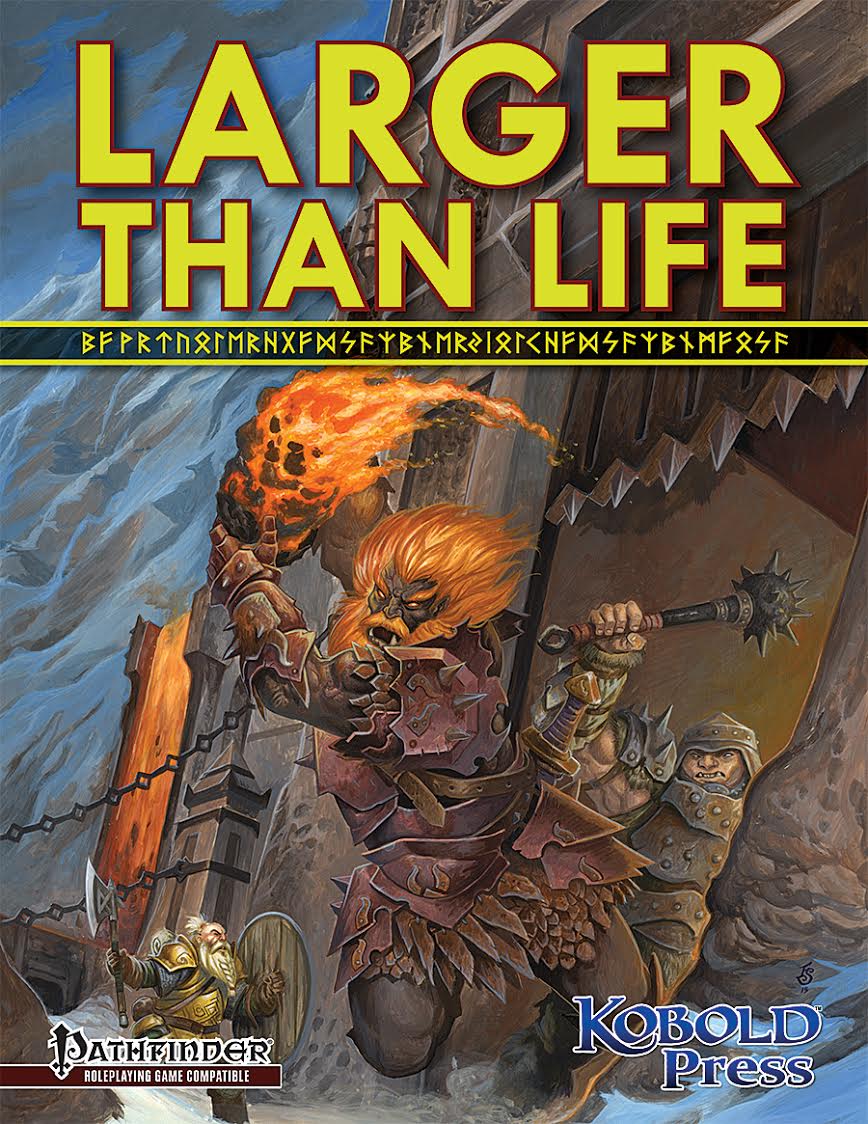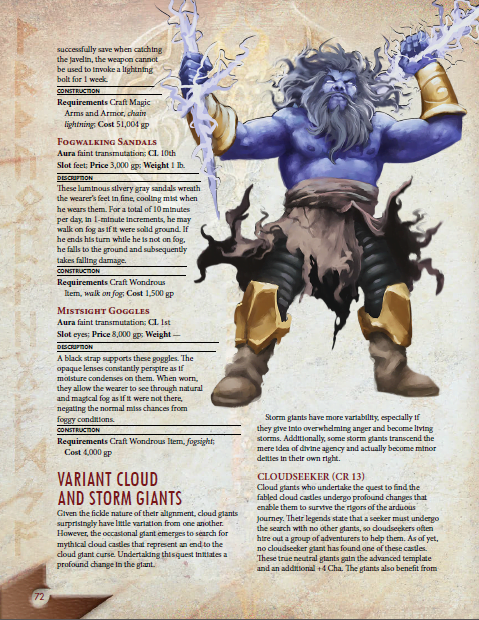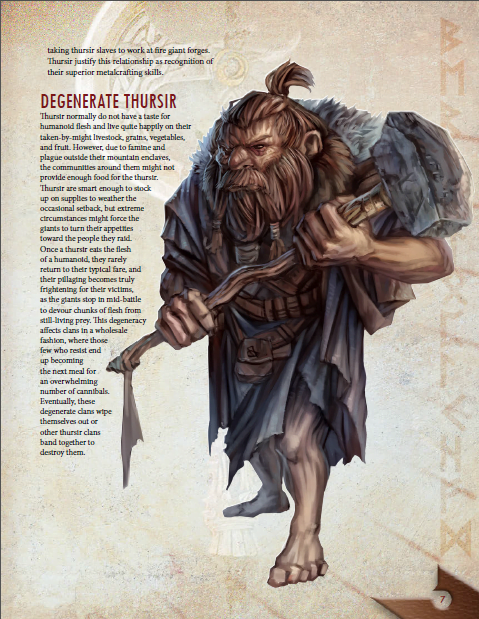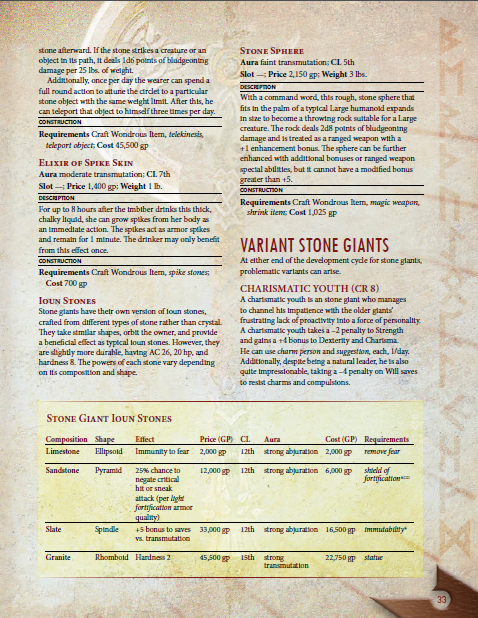Description
The Giants Are Coming!
Rocks will shatter, trees will ignite, bones will break!
Since the beginning of the RPG hobby, giants have been monsters to reckon with. Even the weakest giant towers over its foes and wreaks havoc with sheer physical strength. Give it armor, magic items, and the power of frost, fire, or lightning, and your players have real problems.
Larger Than Life gives you everything you need to bring these terrifying titans to your table. This 76-page book by RPG Superstar Mike Welham offers Thursir, Hill, Frost, Stone, Fire, Cloud, and Storm Giant NPCs—plus new spells, feats and gear to strike terror into the hearts of puny adventurers.
A selection of gigantic highlights includes:
- Berserkers and Avalanche Riders!
- Dung Boulders and Magma Boulders!
- Chieftains, war mammoths, and dire animal companions!
- New stone giants spells from the bones of the earth!
- The runes and metalcraft of the mystic thursir!
- Empyreal weapons and armor of the storm and cloud giants!
Go big and send puny humans packing, grab Larger Than Life today!








Megan Robertson –
What part do giants play in your game? If you’d like them to be distinctive personalities rather than ‘ordinary’ humanoids that just happen to be bigger than anyone else, this might be worth a look.
There’s no introduction or preamble, it just dives straight in to the first section. The book is made up of sections about the different types of giant – thursir, hill giants, stone giants, frost giants, fire giants, and cloud and storm giants – but each section contains a wealth of information that can be used to make them come alive in your game, with details about their history, social organisation and even religious beliefs as well as their relationships with other races and the things they do that are likely to impact on their neighbours. There are hidden gems throughout – for example, thursir like (and excel at) metalwork and feasting, yet they loathe dwarves (who like and excel at metalwork and feasting) with a vengeance. It’s not just jealousy either, there’s a historical (legendary, really) reason behind the emnity. It’s things like that which make them come to life as a people with their own ideas and motivations rather than a mark on a map and a stat block in your notes.
However, it’s not all stories and legends, there are solid game mechanics here as well. Racial feats – treating each different giant type as a separate race (which, biologically speaking, they are) – distinctive items of equipment and even magic are provided, along with fully-developed sample NPCs and ideas for adventure using each giant race.
Of course, the different races come over rather stereotyped. Thursir work wonders in the forge, provided they haven’t been overindulging themselves with food and drink. Hill giants are stupid and a bit thuggish. Stone giants, on the other hand, are quite gentle and peaceful… and delight in their children, something many giants find quite difficult. Frost giants like hunting intelligent prey and will travel great distances to find someone worth hunting. Everyone else is regarded as slave material (or lunch). And so on. Whilst this makes it easy to categorise them, if you want to make them into real societies rather than groups of monsters, remember that the generalisations refer to the race as a whole and individuals may buck the trend… and indeed, there are hints and suggestions as to how not all giants of a given race are exactly the same. To go back to the thursir, while they detest dwarves and stomp on them at any opportunity, some female thursir are so enamoured of the freedoms female dwarves enjoy that they seek out magic to shrink them to dwarf size to mingle with them in secret!
Giants by their very nature do not live within mainstream humanoid civilisation, but they do interact with it. Using this book, you will be able to make giant communities come to life, whether your plot calls for the party to visit or encounter them, or for giants for some reason (probably warlike) to come a-visiting. Make them into something far more than large-scale humanoids to fight, giants can be people too! However, this is very much a book for giants as monsters/NPCs, albeit well-developed ones, if youm want to actually play a giant you will need more than is here although it may provide useful background.
Endzeitgeist –
An Endzeitgeist.com review
This compilation of the Larger than Life-series (plus new pieces) clocks in at 78 pages, 1 page front cover, 1 page editorial, 1 page SRD, 1 page back cover, leaving us with 74 pages of content, so let’s take a look, shall we?
Ah, the blessings of me being swamped in reviews. A couple of small installments are released and once I could get around to them, the big book’s already out there…yeah, I know. I’d love to be faster.
That aside, what we get within the pages of this book is not a simple monster book themed around giants – instead, this book should be considered a kind of combination of ecology + toolkit -and personally, I very much enjoy this approach. Why? Well, at this point, you’ve probably heard me lament the decline of fluff text and the inspiration it brings in various monster-supplements, so yes, this type of book is right up my alley. Furthermore, as someone who likes to tinker with monsters to make them more lethal, any kind of toolkit is definitely appreciated, so let’s break down the giants as presented herein – after all, they probably should differ from what was depicted in Paizo’s Giants Revisited.
This being a kind of ecology toolbox-combination, the respective chapters doe follow a certain structure – we begin each of the entries with a general run-down of motivations, society structure, attitude towards the most common of races. These entries actually go into the details of the respective societies, also providing some instances of usual customs and similar pieces of information that render the entries infinitely more compelling for the GM, and best of all, more inspiring. So yes, kudos for going this route – as far as I’m concerned, I vastly prefer such a detailed look at a given culture. That being said, the entries do not limit themselves to such information – GMs can also look forward to an array of racial feats specifically designed for the respective giants. Beyond those, equipment, variants and spells as well as sample statblocks provide ample crunch fodder for the discerning GM.
Now it should be noted that the respective feats usually actually are racial feats – i.e. they require the creature to be of the respective race, so there is not much chance of actually abusing the feats presented herein. I do welcome this decision due to two facts: One, if a GM truly wants to, he can still flaunt the prerequisite and two, this means that the respective giant types actually utilize different tactics. Finally, beyond the sample builds, adventure seeds can also be found herein. So that’s the structure presented in the respective entries. That out of the way, let us dive into the matter at hand and begin:
The first type of giant depicted would be the Thursir, who also are the most numerous and least pleasant giants as far as humanoids are concerned – they are characterized by not only their predilection for crafting, a certain misogyny and a huge appetite. While not depicted as compulsory cannibals, once tasting the texture of humanoid flesh may render them degenerate and even more frightening. With females often reduced to the traditional roles or that of spellcasters, it should come as no surprise that there are actually feats that allow a cunning thursir lady to be the power behind the throne via suggestion et al. or cut down foes to size with reduce/enlarge person. Thursir may apply magic weapon to weapons they crafted themselves and have some forge-themed tricks, which range from interesting to a bit bland: Fire resistance 10, for example, may be nice, but I have seen that one quite often before. At the same time, synergy with Northland’s rune magic can be considered rather interesting. On the other hand, would you as a GM waste a precious feat-slot for +1 to atk and damage versus dwarves? I don’t care how thematically appropriate anti-X-feats are, their benefit should imho be on par with a feat-investment. So no, not all of the custom-options here are worth taking, though e.g. +10 rounds of rage when starved is NASTY – and yes, it caveats that you usually can’t rage when fatigued. Nice catch! The equipment section is inspired – from field forges and barbed armors to hammers that allow the thursir to bull rush foes, the options are nice. A new special quality and nice magic complements the section.
Hill Giants are depicted in this book in a manner that somewhat deviates slightly from the base concept -while the general stupidity and short-sightedness can still be found within this interpretation of the giant type, they can more be likened to bullies that treat the divine as petulant children would treat their parents. Strangely, they also show a taste for runic magic and while the overall concept may not sound too groundbreaking, the combination of the themes evoked actually makes them frightening in their implications: If big, nasty bullies can destroy you by sheer thoughtlessness, they may be harbingers of things even worse than their own predations. The feats provided here allow the hill giants to blind/deafen foes with attacks, substitute Intimidate for Handle Animal or gain your Int-SCORE to resist attempts to reason with you alongside some general rock catching/squashing-enhancing feats. With liquid bravado, dung boulders and wax to prevent them from succumbing to language-dependent magic, the supplemental material does support the surprisingly frightening concept of this kind of giant. Magical bags of rocks and spells to assess settlements and whether they’re ripe for plunder further make these primitive, lazy bullies a threat to be reckoned with.
Stone Giants have had perhaps one of the most significant re-designs in pathfinder and for a good reason: The old iterations have not been particularly interesting and, in fact, I will always fondly remember RotRL #4 for being the first module wherein I considered stone giants interesting foils. Now the ecology of this book provides not a truly new stance on the concept itself, but rather in the detail – in a perfect example *why* I consider more extensive monster ecologies so vital, stone giant society is depicted as having some almost zen-like quest for truth being part of their decision making: It would not be uncommon for one of these long-lived giants to walk around and ask a multitude of beings the same question, only to return weeks later and draw conclusions after careful deliberation – while this sounds like a small component, it inspired me actually to a large extent, so kudos for that! Supplemental material-wise, we obviously get the stone-related options you’d expect – from better durability and stealth to even getting hardness (!!!), the options are thematically concise and thankfully limited to adversaries. With demoralizing drums and clarity-enhancing moss, the alchemical items also work well regarding the conjunction of strange themes unified in this giant race. Have I mentioned the new ioun stones of the magical stone sphere?
Now as for the Frost Giants, there probably is no giant type less in need of an awesome additional fluff, right? At least as far as I’m concerned, the harbingers of the Fimbulwinter, the scions of ice and snow, perfectly encapsulate all that is awesome about giants and all that renders them cool. Yes, I’m going to put a dime in the bad pun jar for that. That being said, you probably won’t be surprised by me not particularly being keen on more details for them, though rune-enhancing etc. and the accompanying fluff are nice. However, at the same time, I should not fail to mention one particularly awesome “Why didn’t I think of that before”-concept presented among the crunch: The Avalanche Rider-feat. use Ride to literally ride on avalanches. Think about the imagery – the mountains shake and the northmen look up, as a huge white cloud rushes towards the settlement. In panic, magic is woven, children are brought into safe places – and then, not only does white death come above, they hear the thundering of giant feat, sliding into their midst – the giants have come. Yes, I am so going to use this. With auras that deal ice damage and feats to break bones with crits, the frost giant-options herein help set them aside and distinguish them from their brethren.
Conversely, the Fire giants have been a second set of favorites for me, with the Weltenbrand and the inherent discipline and structure conventionally expected from the in-game depiction of fire giants, they pretty much are the opposite side of the coin – and no less awesome. It should hence come as no surprise that the feats sport a burning aura, anti-cold options etc. At the same time, their organization is not just a mirrored law/chaos dichotomy – e.g. deals with devils are not as common as you’d expect and the supreme organization also translates into a better structuring regarding the cooperation with e.g. fire beasts and red dragons. Emitting a heat wave and thus, concealment or leashes of fire made to control trolls provide nice, coherent options that render their society more believable and ultimately, more inspiring for the GM. It should also come as no surprise that this supreme organization also translates to more unique weapon special abilities than for the other giants.
The final section of the book consists of a double ecology depicting Cloud and Storm Giants – which makes sense to me since they do sport some conceptual overlap. The alignment-split and inherent hedonism of cloud giants is depicted in a rather interesting manner, with transitions being described in a rather interesting manner. At the same time, though, it should be noted that storm giants are relegated to an afterthought within the write-ups here, usually receiving one paragraph of a couple of lines – personally, I consider this a somewhat lost chance of further tying the races together ina new and innovative manner, but that may just be me. That being said, the crunch provided for the races tends towards the more awesome side of things: Whether it’s temporary switching of alignments for cloud giants or becoming electromagnetic for storm giants to lightning auras, griffon companions, cloud/fog control, better weather control – there are quite a few options, including temporarily disguising oneself as a medium humanoid. With spells that allow for the strengthening of nature, forcing creatures to assume gaseous form to generating strangling fog with magic, it should come as no surprise that these most magic of giants also receive the most unique spells. And yes, thunderbolt javelins are included in the mix.
Conclusion:
Editing and formatting can still be considered good – but it is a far cry from perfect. While I can live with some minor deviations from default rules-language, whole feats sans proper formatting and a plethora of italicization glitches can be considered slightly annoying. Layout adheres to a nice, printer-friendly 2-column full-color standard and the pdf does sport a few nice, original full-color artworks. The book comes bookmarked with minimal bookmarks: One per chapter – In a book of this size, that’s not enough. To make navigation quicker, nested bookmarks to the respective sub-chapters would have very much been appreciated by yours truly.
Mike Welham is one of my favorite designers for a reason – Mike only rarely disappoints and there is a reason he has found his way more than once on my top ten-lists. Unlike many authors out there, he is both at home in crunch design and fluff, though especially his prose can be considered to be, more often than not, simply glorious. And this creativity can be found in this book, in many of the gloriously-written little details that greatly enhance the respective cultures.
The question you probably have, though, is the following: “Is this any good?” – Yes, yes, it is. Especially the giant-specific content actually really helps making the giants distinct from one another and provide unique tricks that set them apart -some of which are absolutely iconic and inspired. So overall, yes, I consider this book to be a tad bit more inspired than Giants Revisited. And yes, this book makes giants more distinct. That being said, I do believe I have some gripes I can field here: For one, the spells imho could have used more racial material components to make them harder to acquire or more thematically unique – this is a nitpick, though, and not something I will penalize the pdf for. Much like Giants Revisited, though to a lesser extent, this pdf does not solve the issue of giants in PFRPG itself: Giants suck mechanically. The elimination of many immunities giants had in previous editions has made them very susceptible to a plethora of save-or-suck-effects and tricks that simply have taken a big part of the iconic threat they should be out of them.
While the new feats presented herein do help make them more distinct, I couldn’t help but feel that this pdf would have greatly benefited from a first chapter, wherein options to make ALL GIANTS more hardy, a general toolkit collection if you will. Of course, there actually are some specific options that help set them apart and e.g. hardness indeed does help stone giants to have more staying power – but certain classes still have a pretty easy time eliminating giants due to their sucky touch AC. If you have ever featured giants in your game, you’ll probably know what I’m talking about. So yeah, that would be the big, lost chance of this book. While Larger than Life has succeeded in making the giant types more distinct among themselves, the series does not enhance the giant-subtype as opposed to other humanoids, making them, in this one regard, not larger than life.
I am very much aware that this complaint may be deemed unfair and for that I apologize: I usually try to not complain about roads not taken, but in this instance, the experiences I’ve had with giants make it very much impossible to not mention this.
Now if that sounded negative, do not take it as such – this is still very much a very good toolkit, though one that falls short of its own potential to become the state-of-the art giant-book. There is much awesomeness to be found within these pages and Giantslayer-GMs will most certainly cackle with glee when handling this book. It’s just that the glitches and aforementioned oversight constitute two detractors that made this book slightly less awesome to me than what it could have been. Ultimately, I consider this a good addition to the system and hence, my final verdict will clock in at 4 stars – GMs seeking to make giants more distinct definitely should get this book.
Endzeitgeist out.